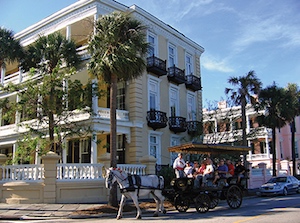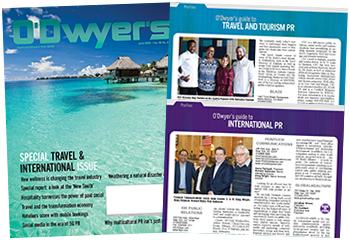 Lou Rena Hammond |
Marketers and manufacturers, the media and developers are focusing their attention on the South. The region has become a powerful economic engine bringing unparalleled growth and opportunity. This isn’t a new phenomenon; it’s a long-term shift that has been occurring over a period of decades.
A quick look at the numbers helps tell the story. The U.S. Census Bureau reports that the South is now home to 38 percent of the U.S. population, with the Southern region growing at the fastest rate in the nation. Stretching from East to West, the Sun Belt states are forecast to account for 88 percent of the population growth between 2000 and 2030, according to Census Bureau reports. The South is also home to ten of the fifteen fastest growing large cities in the U.S. The Southeast Region — generally considered to include twelve states — has experienced a boom in its service economy, manufacturing base, high tech industries and financial sector. This growth has fueled a dramatic increase in housing and office development, as well as expansion of travel infrastructure.
|
|
The region’s favorable climate and quality of life has always contributed to the “Snow Belt to Sun Belt” migration. In increasing numbers, Americans are also heading south in search of jobs and more affordable housing. Sometimes described as “aspirational cities,” they can offer greater upward mobility and opportunity. This population shift has brought with it a change in demographics, with younger, more affluent and hip residents moving into the region. These are the foodies, travelers, adventurers and members of a new creative class that are now the face of the New South.
Manufacturing moves south
The manufacturing industry is being lured to the South by lower taxes and new incentives. Four cities in the Southeast — Nashville, Miami, Raleigh and Atlanta — are on the short list of finalists competing for Amazon’s planned second headquarters in the U.S.
The region’s business-friendly environment has attracted auto manufacturers from the Midwest as well as from Europe and Japan. Offering wide expanses of space for manufacturing facilities, major automotive plants have opened in Montgomery and Mobile, Alabama. Aerospace and defense manufacturers have also expanded their presence in the Southeast to capitalize on the availability of large tracts of land, an available workforce and its strategic location. With its railroads and upgraded port facilities due to the Panama Canal expansion, locations in the Southeast offer access to both domestic and foreign markets. Airbus has opened its first U.S. plant in Mobile, Alabama. Google has opened several data centers in the region, and even Starbucks now has a coffee roasting plant in South Carolina. All of this activity adds up to an ongoing economic boom for the region.
Southern universities, medical and research facilities enhance the region’s reputation as a center of innovation on both a national and international stage.
Media opportunities abound
 Charleston, South Carolina in 2017 was named the “Best City in America” by Travel + Leisure magazine for the fifth year in a row. |
The big news in the media world was the announcement last year by Time Inc. that the company is moving Food & Wine to its multimillion dollar facility in Birmingham, Alabama. It will join its stable of food publications including Cooking Light, Coastal Living and Southern Living. The sprawling complex provides space for 28 test kitchens, photography bays and video studios. The facility also houses a “digital food desk” with its online publications including Food 52 and Eater.
Food & Wine editor Hunter Lewis said that the move gives the publication a more national flavor. “There are sophisticated food eaters and wine drinkers everywhere now, in cities large and small,” he told the New York Times.
While New York may still retain its reputation as the media capital of the nation, regional magazines are zeroing in on local interests. The award-winning Garden & Gun magazine, based in Charleston, SC boasts one of the most affluent audiences in the nation. The monthly magazine covers all things Southern — home and garden, cuisine, travel, arts and culture, sports and events. Similar publications such as Magnolia Journal, Local Palate and the Modern Luxury group cover both the local and national scenes.
Travel and entertainment destination
Visitors continue to be drawn to the Southeast to experience the charm of the Old South along with the vibrancy of the New. In 2016, Charleston, SC was voted number-one “City in the World” by Travel & Leisure. Expanded airline service on national and regional carriers has made these destinations more accessible for both business and leisure travelers. Increased travel has produced a dramatic increase in new hotel construction throughout the region.
Today’s travelers are particularly interested in historic and cultural destinations, as well as scenic locales that are off the beaten path. They are traveling to experience the local scene whether it is the cuisine, arts and entertainment, or the region’s natural beauty.
The fueled economy has brought significant change to the area. We are witnessing the gentrification of old neighborhoods, increasing real estate prices and unprecedented population growth. But, as the New South emerges, the Old South continues to retain its charm, traditions and culture. Southern hospitality and cooking — from the Kentucky Derby and the Grand Ole Opry — and the new South Beach scene are all part of the unique flavor that defines the Southern experience.
***
Lou Rena Hammond is Chairman and Founder of Lou Hammond Group.



 Weber Shandwick is providing PR and marketing communications services to the Moroccan National Tourist Office in New York.
Weber Shandwick is providing PR and marketing communications services to the Moroccan National Tourist Office in New York. Finn Partners has filed its six-month contract with the Bahamas Ministry of Tourism, Investments & Aviation, which is worth $240K.
Finn Partners has filed its six-month contract with the Bahamas Ministry of Tourism, Investments & Aviation, which is worth $240K. Weber Shandwick wrapped up its work for the Ministry of Bahamas at the end of 2023.
Weber Shandwick wrapped up its work for the Ministry of Bahamas at the end of 2023. The Aruba Tourism Authority is boosting its budget 29.4 percent to $2.2M at Zeno Group, according to its 2024 contract, effective Jan. 1.
The Aruba Tourism Authority is boosting its budget 29.4 percent to $2.2M at Zeno Group, according to its 2024 contract, effective Jan. 1. As inflation continues to impact spending, consumers are revisiting their list of what they’re willing to spend more of their money on. Luckily for those in the travel industry, experiences seem to be trending up on the “splurge” list.
As inflation continues to impact spending, consumers are revisiting their list of what they’re willing to spend more of their money on. Luckily for those in the travel industry, experiences seem to be trending up on the “splurge” list. 


 Have a comment? Send it to
Have a comment? Send it to 
No comments have been submitted for this story yet.